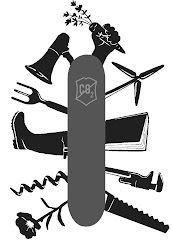 Everyone’s been clipping everything in sight since we’ve had some sunshine here. On Monday the council used a petrol ride-on mower for all the grassy paths, the neighbours had a gardener doing their lawn with an electric push-mower, all the housing associations sent their hedge-clipping-chainsaw-thing man round and almost everyone else I saw was laboriously hacking at hedges and undergrowth with blunt shears while sweating a lot. So it might be a bit late to tell you this.
Everyone’s been clipping everything in sight since we’ve had some sunshine here. On Monday the council used a petrol ride-on mower for all the grassy paths, the neighbours had a gardener doing their lawn with an electric push-mower, all the housing associations sent their hedge-clipping-chainsaw-thing man round and almost everyone else I saw was laboriously hacking at hedges and undergrowth with blunt shears while sweating a lot. So it might be a bit late to tell you this.
It’ll all need doing again in about two weeks though, and the simple non-electrified garden shears that most of us use are about a hundred times easier and more effective to use if you maintain them properly, so here’s how to sort out a pair of shears:
First wipe them clean so you’re dealing with handles and blades rather than a layer of plant goo and grit. Little bits of grit will totally mess up the sharp edges and the pivot, so rinse them even if they don’t seem muddy, just in case.
Close the blades together, hold them up to the light, and look between the blades to see how well aligned they are. If the blades are bent away from each other even a tiny bit then at best they’ll only cut part-way through everything. If they meet at the pivot and the tip but there’s a chink of light in the middle then you’re holding a pair of self-blunting shears. Blades bent in towards each other will scrape their sharp edges together every time you close them, so they’ll be blunt in no time even if you just open and close them without cutting anything.
Bend the blades carefully back into shape until they pass each other very closely and lie flat against each other – you shouldn’t see any light between them sideways-on when they’re shut. I tend to do this by wedging one handle between my foot and the ground, putting a brick under the part of the blade I want to bend, another brick under the loose handle to stop the blades closing together, and then pushing with slow steady pressure on the blade until I can just feel it start to move. Don’t hammer blades or apply pressure too fast in case they snap, and check the chink of light between the blades every time you may have bent them even slightly – a little makes a lot of difference!
Once you’re sure they’re aligned properly, sort the pivot joint out. If they’re stiff you might have grit or gunk in the joint, which a scrub with an old toothbrush in warm soapy water will probably sort out. If it’s rusty then take as much rust off as you can with fine sandpaper and wipe clean with something dry. Then work some oil into the joint so it opens and closes easily. If they’re still stiff then it might be worth undoing the bolt to sand the parts you can’t otherwise reach, putting the bolt itself in Coca-Cola overnight before cleaning its screw thread with a toothbrush and soapy water, then drying and oiling the whole thing before putting it back together.
Finally, you need a sharpening stone. If you’ve ever chewed a piece of grass you’ll know that it’s very fibrous, and so are woody things like hedges. Clipping the stuff will blunt blades quite quickly, so they need sharpening up again every ten minutes or so to keep them cutting easily, otherwise you’ll spend lots of effort just bruising grass.
If they haven’t been sharpened for ages then it’ll take a bit longer first time, but once they’re done they’ll only need a few scrapes to get going again when they start to lose their edge. If they’re very blunt or if there are any nicks in the blades, take them to a locksmith-and-cobblers shop first and ask nicely if they’ll grind them on their machines before you use a sharpening stone for a smoother finish.
Get the sharpening stone wet, look at the blade to see where the tiny slope at the edge is, then drag that sloped bit across the stone – you don’t need to press very hard. If you then look again at the blade the part you’ve scraped will be shiny, so you’ll see easily if you’ve got the angle right and with a bit of trial and error you’ll soon work out how to get a decent sharp edge on a blade – ask a good chef to teach you how to sharpen a knife if you're struggling.
Go off and cut things, enjoy the nice clean slicey noise they’ll now be making, remember to sharpen again a little bit every ten minutes or so, and you’ll gradually stop thinking of shearing as really hard and difficult work.
No petrol, no battery, no mains lead, no fuel costs, no sweat.

















1 comment:
Sharpen them when you feel like a rest.
Post a Comment